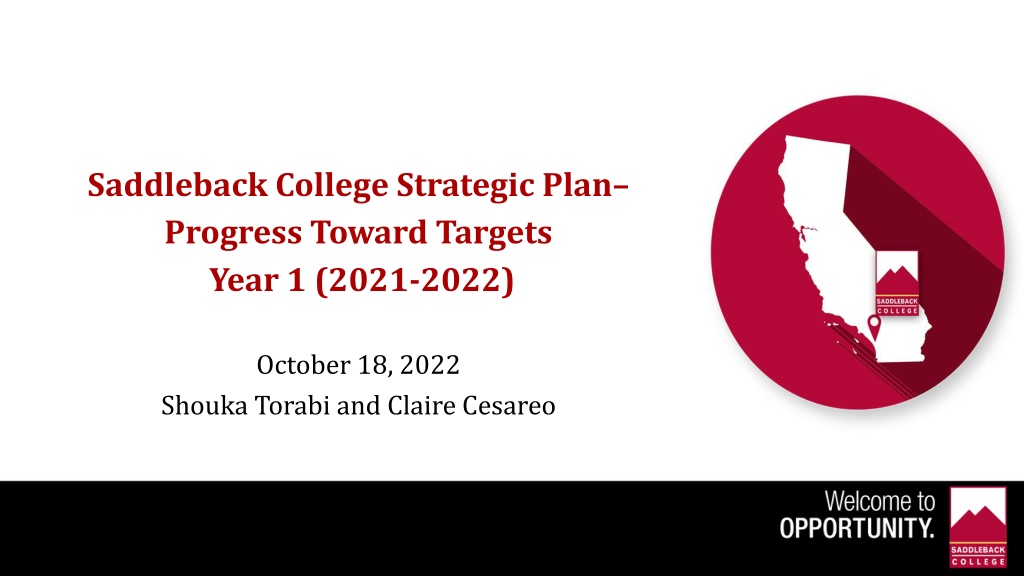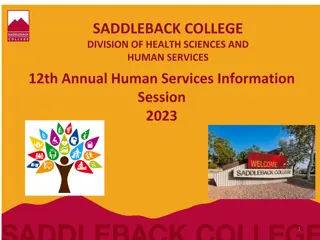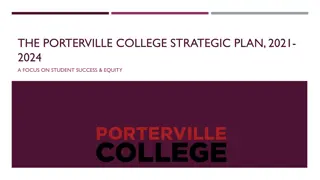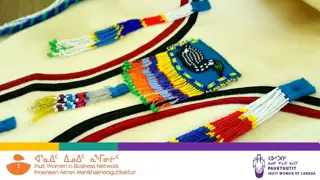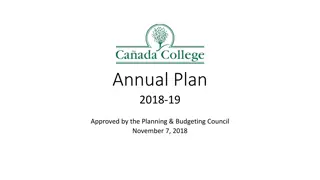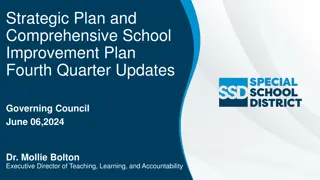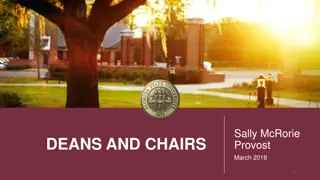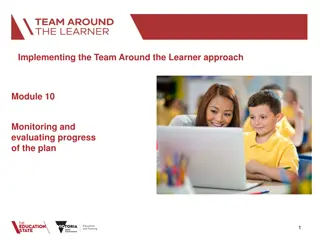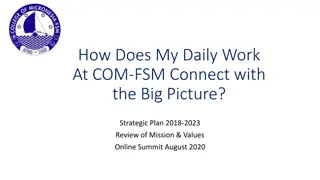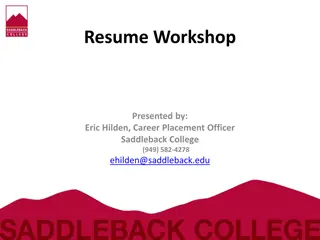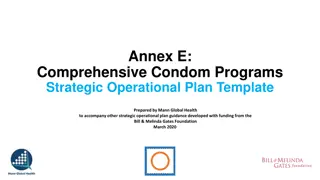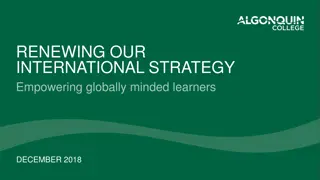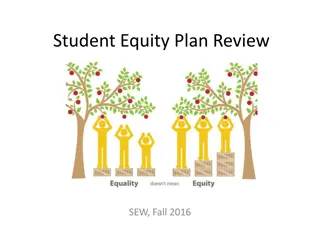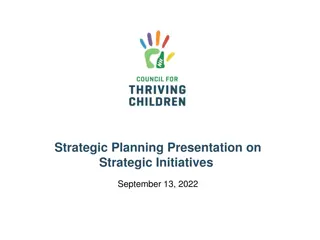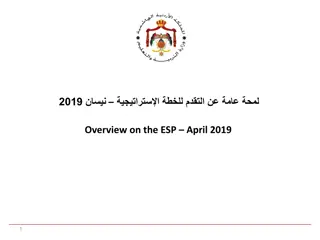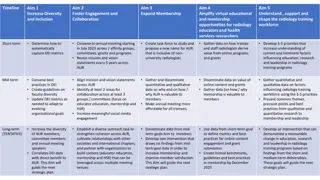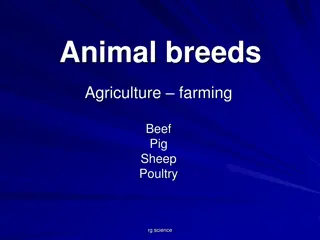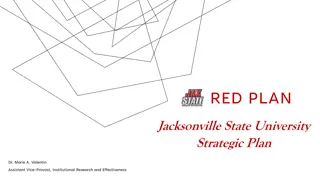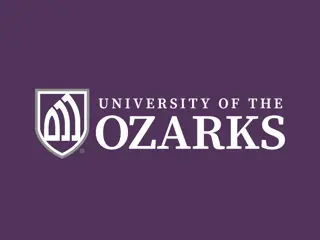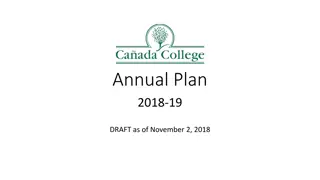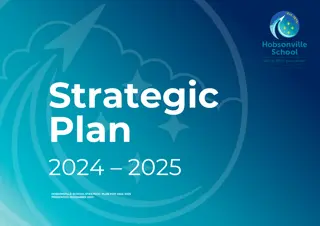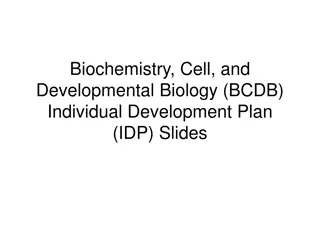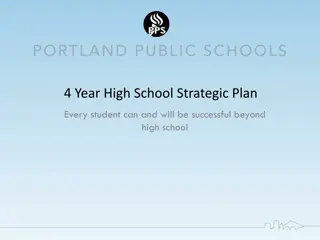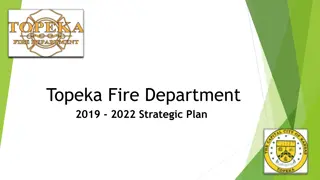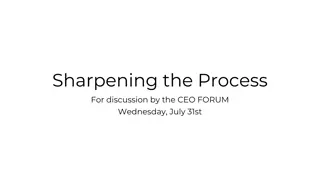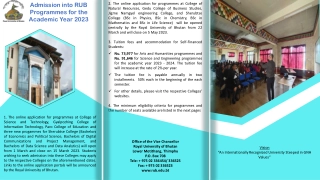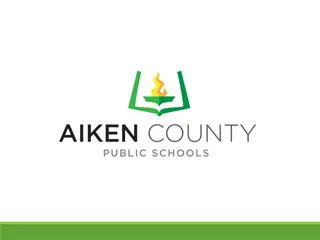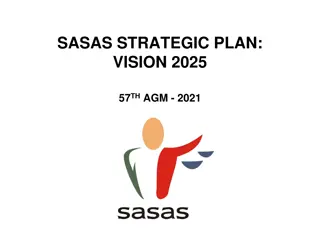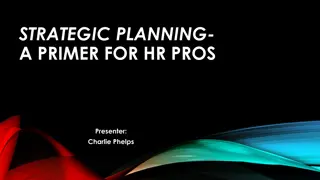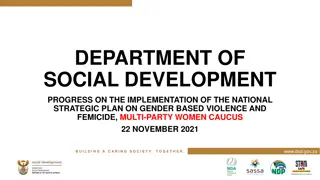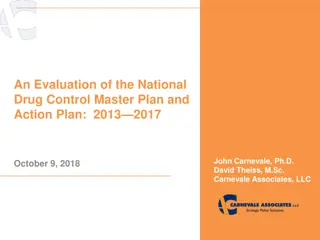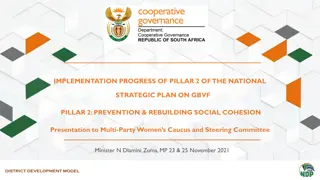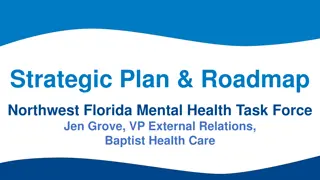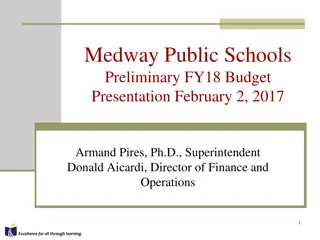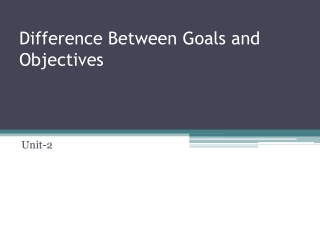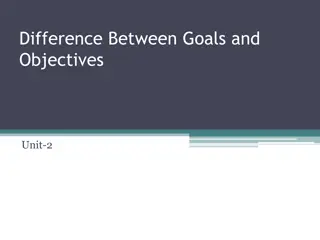Saddleback College Strategic Plan Progress and Goals
Saddleback College's strategic plan details progress towards objectives for Year 1 (2021-2022), upcoming objectives for Year 2 (2022-2023), and overarching goals for 2020-2025. The focus is on ensuring student equity, transforming lives through learning, engaging with the community, and optimizing institutional design. Specific objectives aim to reduce achievement gaps and improve outcomes for diverse student populations. The plan utilizes data and cohort-based models to track progress and eliminate disparities.
Download Presentation

Please find below an Image/Link to download the presentation.
The content on the website is provided AS IS for your information and personal use only. It may not be sold, licensed, or shared on other websites without obtaining consent from the author. Download presentation by click this link. If you encounter any issues during the download, it is possible that the publisher has removed the file from their server.
E N D
Presentation Transcript
Saddleback College Strategic Plan Progress Toward Targets Year 1 (2021-2022) October 18, 2022 Shouka Torabi and Claire Cesareo
Agenda for Today 1. Progress Toward Targets - Year 1 2. Proposed Prioritized Objectives for Year 2 (2022-2023) 3. Planning Efforts and Reporting Progress
Strategic Plan Goals (2020-2025) GOAL 1: Ensure student equity in access and achievement (7 objectives) GOAL 2: Transform lives through learning and achievements (11 objectives) GOAL 3: Engage with the community through athletic and cultural events, enrichment programs and in creating economic prosperity for all (6 objectives) GOAL 4: Optimize our institutional design and structure with a student- centered focus (5 objectives)
Goal 1 - Objectives Review 1.1 1.2 1.3 1.4 1.5 1.6 1.7 Reduce achievement gap in certificate, degree, transfers, 9-unit CTE Reduce achievement gap in transfer-level English and math completion in the 1styear Reduce achievement gap in online and face-to-face course success Reduce achievement gap in application to enrollment Reduce achievement gap in Persistence (F2F and F2Sp) Reduce explicit and implicit bias Reduce institutional bias
Goal 1 - DI Groups Cohort-based model - First-time college students with an educational goal of degree/cert or transfer students were tracked for three years prior to the 2019-20 outcome year (baseline). A Proportionality Index (PI) was applied to measure disproportionate impact (DI). Each objective was broken down by ethnicity, age, gender, economically disadvantaged, first generation, foster youth, veterans, and those with disabilities. The following student groups were identified as having the greatest number of achievement gaps: Black/African-American LatinX First-Generation Students 25 and over Established 5-Year Target: Eliminate all achievement gaps
Objective 1.1 - LatinX students slightly improving for certificate completions Certificate (2019-2020) Certificate (2020-2021) 1.20 0.82 1.17 0.84 Gender Female Male 1.30 0.84 Ethnicity American Indian or Alaska Native 1.48 0.49 0.79 1.45 0.58 0.80 Asian Black or African American Hispanic/Latino 0.63 0.52 Native Hawaiian or Pacific Islander 1.03 0.79 1.08 1.10 0.47 0.90 0.71 0.63 0.27 0.89 1.14 0.60 1.06 1.10 0.45 0.93 0.70 0.52 0.50 0.84 Two or More Races Unreported/Unknown White Ages 0-24 Ages 25+ Economically Disadvantaged First-Generation Veteran Foster Youth DSPS Age Special Populations
Objective 1.1 - LatinX students slightly improving for degree completions Degree (2019-2020) Degree (2020-2021) 1.19 0.82 1.17 0.84 Gender Female Male 1.26 0.82 Ethnicity American Indian or Alaska Native 1.47 0.58 0.78 1.44 0.66 0.80 Asian Black or African American Hispanic/Latino 1.02 0.69 Native Hawaiian or Pacific Islander 1.01 0.84 1.08 1.09 0.50 0.90 0.71 0.62 0.26 0.90 1.13 0.63 1.06 1.09 0.48 0.93 0.71 0.51 0.49 0.85 Two or More Races Unreported/Unknown White Ages 0-24 Ages 25+ Economically Disadvantaged First-Generation Veteran Foster Youth DSPS Age Special Populations
Objective 1.1 - No Progress in primary DI groups for transfers to 4-year institutions Transfer (2019- 2020) 1.09 Transfer (2020- 2021) 1.08 Gender Female 0.91 0.92 Male 1.19 0.89 Ethnicity American Indian or Alaska Native 1.02 1.05 Asian 0.78 0.69 Black or African American 0.71 0.73 Hispanic/Latino 0.72 0.87 Native Hawaiian or Pacific Islander 1.14 1.16 Two or More Races 0.84 0.80 Unreported/Unknown 1.15 1.14 White 1.11 1.12 Age Ages 0-24 0.37 0.31 Ages 25+ 0.85 0.83 Special Populations Economically Disadvantaged 0.59 0.56 First-Generation 1.15 0.94 Veteran 0.49 0.68 Foster Youth 0.72 0.72 DSPS
Objective 1.2 - First-Gen students improving in completion of transfer- level English in the 1styear Transfer English (2019- 2020) Transfer English (2020- 2021) 1.06 0.94 1.03 0.97 Gender Female Male 0.62 0.49 Ethnicity American Indian or Alaska Native 0.97 0.64 0.87 0.53 1.08 0.75 1.10 1.09 0.39 1.01 0.59 0.89 0.82 1.07 0.82 1.09 1.09 0.42 Asian Black or African American Hispanic/Latino Native Hawaiian or Pacific Islander Two or More Races Unreported/Unknown White Ages 0-24 Ages 25+ Age 0.92 0.96 Economically Disadvantaged Special Populations 0.77 0.89 0.58 0.86 0.83 0.96 0.65 0.88 First-Generation Veteran Foster Youth DSPS
Objective 1.2 - LatinX students improving in completion of transfer- level math in the 1styear Transfer Math (2020-2021) Transfer Math (2019-2020) 0.98 1.02 0.99 1.02 Gender Female Male 0.48 0.20 Ethnicity American Indian or Alaska Native 1.76 0.52 0.75 1.48 0.40 0.82 Asian Black or African American Hispanic/Latino 0.20 0.69 Native Hawaiian or Pacific Islander 1.02 0.76 1.06 1.11 0.27 0.90 0.62 0.67 0.44 0.80 1.08 0.95 1.06 1.11 0.33 0.93 0.72 0.83 0.40 0.83 Two or More Races Unreported/Unknown White Ages 0-24 Ages 25+ Economically Disadvantaged First-Generation Veteran Foster Youth DSPS Age Special Populations
Objective 1.2 - LatinX students improving in completion of transfer- level math and English in the 1styear Transfer English & Math (2019-2020) Transfer English & Math (2020-2021) 1.01 0.99 1.01 0.98 Gender Female Male 0.59 0.24 Ethnicity American Indian or Alaska Native 1.54 0.39 0.76 1.39 0.38 0.82 Asian Black or African American Hispanic/Latino 0.25 0.82 Native Hawaiian or Pacific Islander 1.04 0.71 1.10 1.13 1.04 0.92 1.08 1.12 Two or More Races Unreported/Unknown White Ages 0-24 Age 0.16 0.22 Ages 25+ Special Populations 0.89 0.93 Economically Disadvantaged 0.59 0.64 0.42 0.73 0.72 0.80 0.34 0.76 First-Generation Veteran Foster Youth DSPS
Goal 2 - Objectives Review 2.1 Increase the number of students annually who earn associate degrees, certificates, or 9 units in a CTE program 2.2 Increase the number of students transferring annually 2.3 Increase completion rates in transfer-level math and English within the 1styear 2.4 Increase course success in online and traditional classroom classes 2.5 Increase student Persistence Rate (F2F and F2Sp) 2.6 Increase the percent of exiting CTE students who report being employed in their field of study 2.7 Reduce average units accumulated by students who complete degrees 2.8 Implement educational programs and student services to identified non-traditional students 2.9 Increase and support the number of outside classroom learning opportunities available for students in each division 2.10 Create and support inter-disciplinary learning opportunities both within and across the colleges 2.11 Increase the number of professional development opportunities for faculty and staff
Objective 2.3 No major change in the completion rate of math and English within the 1styear Established 5-Year Target: 20% increase by 2024-25
Objective 2.5 Slight decline for both rates Fall-to-Spring Persistence Fall-to-Fall Persistence Established 5-Year Targets: 85% for F to Sp persistence ; 60% for F to F persistence by 2024-25
Objective 2.8 12% decline in students who are 25+ Established 5-Year Target: 5% increase by 2024-25
Goal 3 - Objectives Review 3.1 Strengthen and expand industry partnerships to support student learning, program development, and regional economic development 3.2 Increase the number of students who reported obtaining a job closely related to their field of study 3.3 Increase participation in extended learning (community/adult education programs, emeritus institutes) 3.4 Increase the number of students who earn college credits while still in high school 3.5 Increase partnerships with higher education institutions 3.6 Increase community participation in civic, athletic, and cultural events
Objective 3.3 Slight decline in Adult Ed; 31% decline in Emeritus Adult Education (Headcount) Emeritus (Headcount) Established 5-Year Targets: 5% increase by 2024-25
Objective 3.4 Observed decline in headcount (9%) but higher enrollments in college credits Dual-Enrolled (Enrollment) Dual-Enrolled (Headcount) Established 5-Year Targets: 5% increase by 2024-25
Goal 4 - Objectives Review 4.1 Identify and streamline all institutional policies, practices, and processes pertaining to facilities and technology 4.2 Develop an organizational culture of collaboration across the district 4.3 Create a sustainable and robust participatory governance evaluation process 4.4 Provide enhanced student support with a student-centered design 4.5 Develop and build out the ATEP vision for the colleges, including public-private partnerships
Objective 4.2 Data in Discussion at the District Established 5-Year Target: TBD
Objective 4.3 This objective does not have a data point to capture change. The college has made progress in the following areas related to participatory governance: Reviewed and approved a new Decision-Making Manual Review of committee evaluation instrument to ensure effectiveness Resource allocation process was evaluated to maximize achievement of outcomes Established 5-Year Target: Not Applicable
Proposed Prioritized Objectives for Year 2 (2022-2023) GOAL 1 1.4 Reduce achievement gap in application to enrollment (Access) 1.6 - Reduce explicit and implicit bias GOAL 3 3.1 Strengthen and expand industry partnerships to support student learning, program development, and regional economic development 3.5 Increase partnerships with higher education institutions GOAL 4 4.4 Provide enhanced student support with a student- centered design GOAL 2 2.11 Increase the number of professional development opportunities for faculty and staff Note: These are in addition to the Year 1 objectives.
Planning Efforts and Reporting Progress Strategic Planning Efforts for 2022-2023: Fall 2022 PIE chairs present on progress of Year 1 toward 5-year targets (PIE and CC) OPRA will develop an automated form to submit action steps for Year 2 Goal leads will work with committee chairs and key stakeholders to capture Year 2 action steps Goal leads to share progress, in PIE, on collecting Year 2 action steps, at the end of term Spring 2023 Goal leads will capture progress on Year 2 action steps Goal leads to share progress, in PIE, on progress made on action steps, at the end of term Hold Planning Retreat with goal leads to prepare for Year 3
THANK YOU! Data Source: Strategic Plan Indicators Dashboard (socccd.edu)
